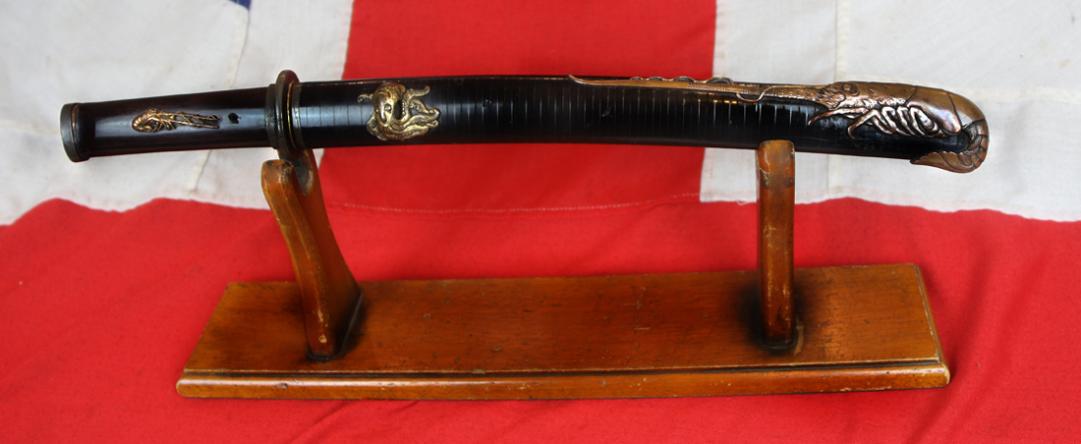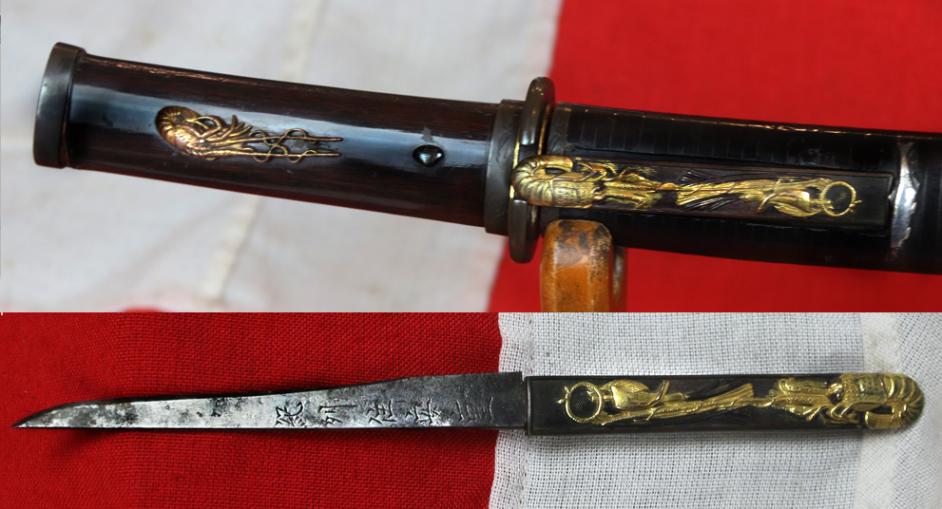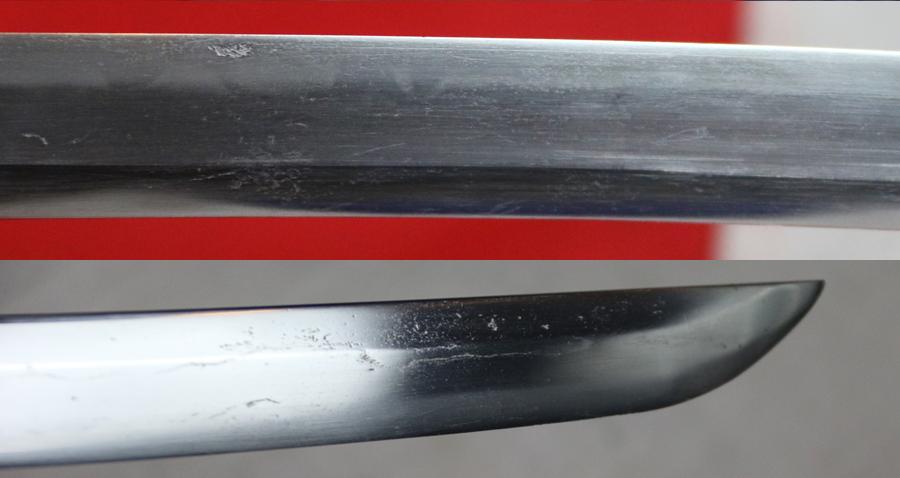A Fabulous and Stunning, Original, Edo Period Mounted Long Tanto with Koto era Sengoku Period, Circa 1500's Blade & a Remarkable Secret Compartment for a Secret Letter or Gold
A wonderful Japanese art sword in the truest sense of the word, with a Koto blade circa 1500. All the wonderful koshirae are based on sea creatures, such as numerous gold Japanese spiney lobster on the sayajiri and menuki, with a takebori octopus Akkorokamui kurigata, and the shakudo fushi kashira are katakiribori engraved with a koi carp, an Akkorokamui octopus and a turbot, an eel on the shakudo tsuba, and a silver fish at the base of the kozuka pocket, and the kozuka has a stunning gold spiny lobster to match the mountings. The blade is fixed into place, as the hidden secret compartment, hidden under the rare removable kashira, would be where the tang would normally be, thus the hilt would normally be solid and the secret compartment, in the hollow tsuka hilt, would not be remotely suspected. Original Edo period black stripe and counter stripe lacquer saya
Akkorokamui is a gigantic octopus-like monster from Ainu folklore, which supposedly lurks in Funka Bay in Hokkaidō and has been allegedly sighted in several locations including Taiwan and Korea since the 19th century. John Batchelor most notably records an account of this monster in his book The Ainu and Their Folklore when noting, “...three men, it was said, were out trying to catch a sword-fish, when all at once a great sea-monster, with large staring eyes, appeared in front of them and proceeded to attack the boat. The monster was round in shape, and emitted a dark fluid which has a very powerful and noxious odour.” It is said that its enormous body can reach sizes of up to 120 meters in length. The coloration of the Akkorokamui is said to be a striking red, often described as glowing and sometimes likened to the color of the reflection of the setting sun upon the water. Due to its coloration and immense size, it is visible from great distances. It is possibly a giant squid or a giant octopus.
Ainu reverence of this monster has permeated into Shintoism, which has incorporated Akkorokamui as a minor kami. Self purification practices for Akkorokamui are often strictly followed. While Akkorokamui is often presented as a benevolent kami with powers to heal and bestow knowledge, it is fickle and has the propensity to do harm. Akkorokamui’s nature as an octopus means that it is persistent and it is near impossible to escape its grasp without permission. Like other Shinto purification rituals, prior to entering the shrine of Akkorokamui, one’s hands must be cleaned with water with the exception that one’s feet must also be cleaned as well. Akkorokamui enjoys the sea and offerings which reflect this: fish, crab, mollusks, and the like are particular favorites of Akkorokamui, which give back that which it gave. Homage to Akkorokamui is often for ailments of the limbs or skin, but mental purification and spiritual release is particularly important.
Shrines in dedication to Akkorokamui and associated octopus deity are found throughout Japan. In particular, well known shrines include one in Kyoto and the island of Hokkaido that pay homage to Nade yakushi. These shrines, while named to different entities, come from and share various characteristics with Akkorokamui, and as such practices involving healing, renewal, and purification are similar. Koi fish are associated with positive imagery. Because of the dragon legend, they are known as symbols of strength and perseverance, as seen in their determinative struggle upstream. And because of the lone koi that made it to the top of the waterfall, they are also known as symbols of a destiny fulfilled. Resulting from its bravery in swimming upstream, the koi is oftentimes associated with Samurai Warriors in Japan. The Sengoku period Sengoku Jidai, "Warring States period") is a period in Japanese history of near-constant civil war, social upheaval, and intrigue from 1467 to 1615.
The Sengoku period was initiated by the Ōnin War in 1467 which collapsed the feudal system of Japan under the Ashikaga Shogunate. Various samurai warlords and clans fought for control over Japan in the power vacuum, while the Ikkō-ikki emerged to fight against samurai rule. The arrival of Europeans in 1543 introduced the arquebus into Japanese warfare, and Japan ended its status as a tributary state of China in 1549. Oda Nobunaga dissolved the Ashikaga Shogunate in 1573 and launched a war of political unification by force, including the Ishiyama Hongan-ji War, until his death in the Honnō-ji Incident in 1582. Nobunaga's successor Toyotomi Hideyoshi completed his campaign to unify Japan and consolidated his rule with numerous influential reforms. Hideyoshi launched the Japanese invasions of Korea in 1592, but their eventual failure damaged his prestige before his death in 1598. Tokugawa Ieyasu displaced Hideyoshi's young son and successor Toyotomi Hideyori at the Battle of Sekigahara in 1600 and re-established the feudal system under the Tokugawa Shogunate. The Sengoku period ended when Toyotomi loyalists were defeated at the siege of Osaka in 1615.
The Sengoku period was named by Japanese historians after the similar but otherwise unrelated Warring States period of China. Small natural wear marks to the lacquer. Blade 14 inches long tsuba to tip, 19.5 inches long overall. More details to follow.....
Code: 23929










